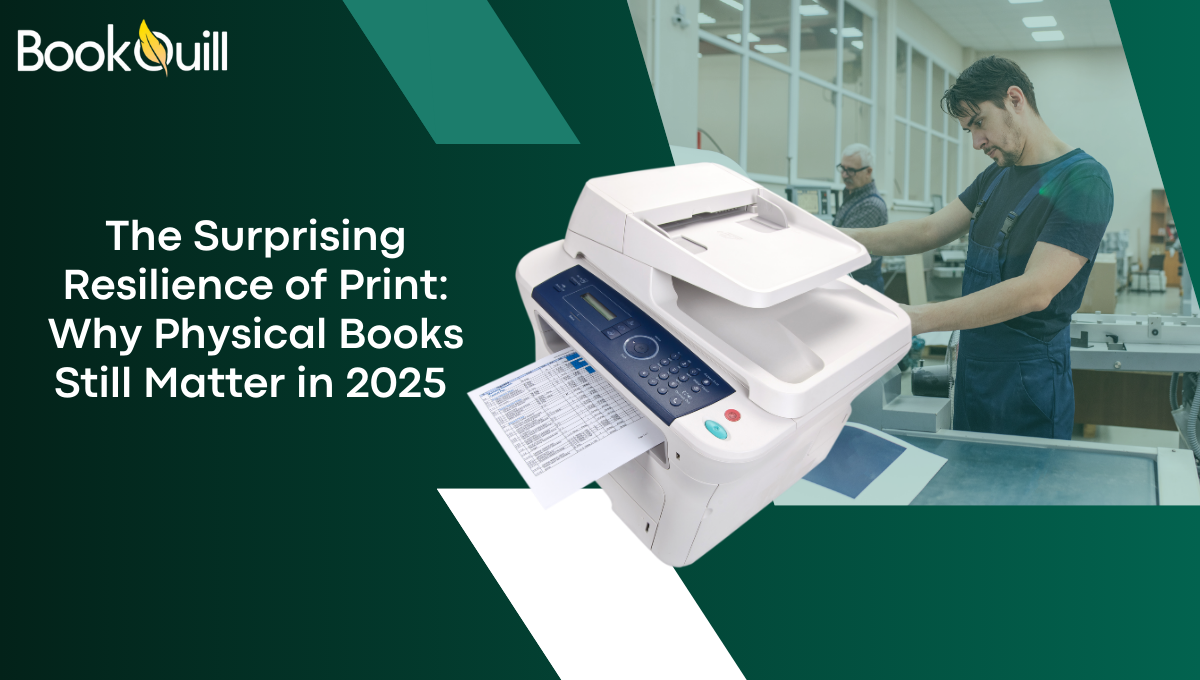The Surprising Resilience of Print: Why Physical Books Still Matter in 2025
Do you know that Amazon’s revenue increased 179% from $233 billion in 2018 to $650 billion in 2025? What does...

Do you know that Amazon’s revenue increased 179% from $233 billion in 2018 to $650 billion in 2025?
What does this tell you?
eBooks are being read A LOT by people. So much so that by 2029, there will be over 1.1 billion eBook consumers.
Well, this sudden increase in eBook reading was expected. Why? Because they offer:
- Increased convenience
- Greater accessibility
- eBook makes it easy for busy individuals to read
Now, this does not mean that physical books are going extinct. You might hear people say, “Oh, in the coming future, you’ll not see people holding books. Everything can be found and read on the phone.”
We are not saying this is not true, but we also know that there is nothing in this world that can replace the feeling of holding a book in your hand, flipping through pages, and breathing that familiar scent of paper. These are tied to our feelings of comfort and nostalgia. Something that is truly irreplaceable.
But apart from our feelings, have you ever wondered how physical books are still so resilient in our new digitized world?
Let’s find out.
Key Takeaways
- Physical books create stronger emotional and sensory connections that screens cannot replicate, making reading more memorable and immersive.
- Print reduces screen fatigue, offering a healthier, more focused alternative to digital reading.
- Readers retain and comprehend information better with print, especially in education, professional development, and deep literary engagement.
- Books are distraction-free by design, supporting better focus and uninterrupted reading experiences.
- Physical books hold cultural and personal value, often used as gifts, collectibles, and identity markers.
- Indie and small publishers thrive with print, using premium finishes and custom printing to serve niche audiences.
- Print remains reliable during crises, functioning without power, internet, or digital glitches.
- Children’s learning benefits greatly from print, which supports motor skills, attention spans, and language development.
Why People Still Love Physical Books
1. Tangibility Creates a Stronger Connection
The experience of physically holding a book plays a significant role in building emotional and mental engagement with the content. This hands-on interaction stimulates more than just reading; it creates a multi-sensory experience that screens cannot fully match.
Why this matters:
- Turning pages offers physical satisfaction that swiping does not.
- The weight of a book provides tactile feedback and a sense of progress.
- Cover materials, paper texture, and finishes contribute to a personalized reading experience.
Physical books are not just tools for reading; they are valued physical objects that add depth to how people consume stories or information.
2. Screen Fatigue Is Real
Daily screen use has skyrocketed, leading to widespread digital eye strain. Readers increasingly seek out non-digital ways to unwind.
Physical books provide relief:
- No backlighting reduces eye strain significantly.
- Absence of alerts or pop-ups helps readers focus for longer.
- No blue light means better pre-sleep reading habits.
Print books provide a reliable solution as people look for healthier screen alternatives.
3. Physical Books Are Distraction-Free by Design
E-readers and tablets come with inherent distractions. Notifications, multi-app switching, and battery limitations all affect reading continuity.
Print eliminates these digital intrusions:
- No push notifications to break immersion.
- No temptation to multitask.
- No app glitches, syncing errors, or low battery interruptions.
When focus is a priority, physical books offer a distraction-free zone by default.
4. Books Are Cultural Artifacts
Books preserve ideas and identity in ways that digital files do not. They carry with them not only stories but also the contexts in which they were read, shared, or displayed.
Their legacy includes:
- Collectible editions that grow in personal or monetary value.
- Older editions that offer nostalgia or historic value.
- Libraries and bookstores that support community and culture.
Even in the digital age, books serve as a cultural timestamp and conversation piece.
5. Print’s Role in Escapism
Reading is a way to escape, and having a physical book enhances that escape. When you pick up a real book, you can put away notifications, messages, and other online distractions. By turning off your device and opening a paperback, you create a calm moment that helps you focus.
6. The Economic Resilience of Print Publishing
Publishers are still working with premium book printing services and betting big on print because it works.
Data shows that print books often generate higher profit margins per unit than eBooks, partly because readers are willing to pay more for the physical product.
For authors, print books also open up:
- Speaking engagements and book signings.
- They can be given as gifts.
- Placement in retail stores.
- Media visibility through cover features.
In short, print keeps authors present in spaces where digital formats can’t reach.
7. Book Ownership Reflects Identity
People still proudly display their bookshelves. Unlike digital libraries, physical collections are visible markers of personality, learning, and curiosity.
Owning physical books offers:
- A way to showcase intellectual or emotional milestones.
- Tangible evidence of progress and growth.
- Motivation to re-read or continue exploring genres.
8. The Rise of Indie Authors
Indie authors are writers who publish their own books. Also, many new indie authors are also about design. With a great focus on unique sizes, shapes, and materials, it’s a new way for indie authors to get attention from the audience.
They work with the best custom book printing services. This gives them the freedom to design and print books. Their designs not only show the content but also help them create a unique identity.
9. Print Has Proven Resilience in Crises
From tech outages to global pandemics, print has remained accessible. It doesn’t rely on hardware, connectivity, or power.
Why this matters:
- Always available regardless of infrastructure issues.
- Immune to data breaches or software errors.
- Perfect for crisis preparedness, homeschooling, or rural areas.
Physical books offer unmatched reliability and independence.
10. Physical Books in Education and Childhood Development
Print remains essential in the educational development of children and students.
Why parents and educators prefer print:
- Supports motor skills through tactile interaction.
- Helps build vocabulary and attention spans.
- Reduces passive screen consumption, promoting active engagement.
Especially in early learning and primary education, physical books remain irreplaceable tools.
Conclusion
Print books are not relics. They are resilient companions in a digital age. While eBooks and audiobooks add convenience, physical books continue to offer something deeper. It offers a slower, richer, and more human experience of reading.
With everything going digital and our lives tied to screens, so much so that even painting has been digitized, we believe that reading, with its human touch, should remain untouched.
FAQ’s
Do authors still prefer publishing print books?
Many do. Print books give authors credibility in bookstores, at speaking events, and in media interviews. Having a tangible copy of their work often helps writers build stronger personal connections with readers.
Is print-on-demand better than bulk printing?
It depends on your goals. POD is best for small budgets and testing the market, while working with the best bulk book printing services is more cost-effective if you expect high sales volume.
Are physical books environmentally friendly in 2025?
Yes. Many printers now offer recycled paper, soy-based inks, and eco-friendly packaging, making print more sustainable.
Do physical books hold value for mental health?
Yes. Many therapists recommend print reading as a way to reduce screen fatigue, calm the mind, and encourage mindfulness. The slower pace of print reading can reduce anxiety and help people disconnect from constant digital stimulation.
How do print books influence children’s reading habits?
Studies show that children engage better with print books because the physical act of turning pages and looking at illustrations creates deeper memory associations. Parents often report that bedtime reading with physical books helps kids focus longer and develop stronger language skills.




